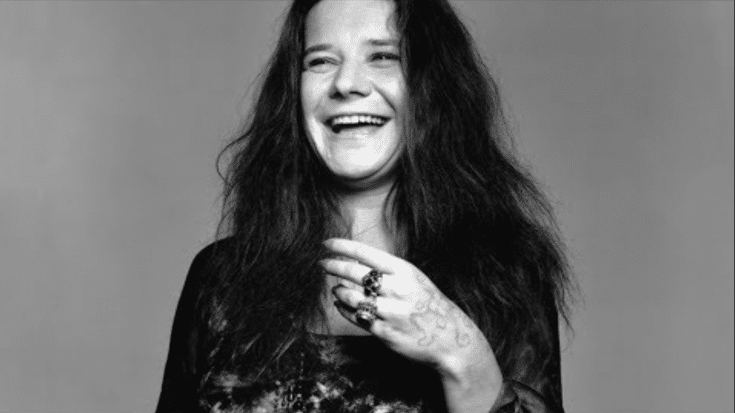The Real Story of the Joyful and Humorous Janis Joplin

via The Firewall / YouTube
In the summer of 1970, amid the vibrant atmosphere of the Festival Express tour, Janis Joplin engages in a candid conversation with her newfound friend Bonnie Bramlett.
“That’s the good thing about women, man… they sing their fuckin’ insides, man,” Janis exclaims. “Women, to be in the music business, give up more than you’d ever know… a home and friends, children and friends. You give up an old man and friends, you give up every constant in the world except music. That’s the only thing in the world you got, man. So for a woman to sing, she really needs to or wants to…”
Janis and Bonnie discuss the female rock experience in the bar car of a train during the Festival Express tour in 1970. The tour features Janis, Delaney & Bonnie, The Grateful Dead, The New Riders Of The Purple Sage, Ten Years After, and various musicians, making stops in Toronto, Winnipeg, and Calgary for open-air performances.
On the train, day and night blur in an alcoholic haze of all-star jams and confessions. The Million Dollar Bash journey becomes legendary, eclipsing the concerts. Janis, captivated by Rolling Stone’s David Dalton, bonds with Bramlett.
“All my life I just wanted to be a beatnik – meet all the heavies, get stoned, get laid, have a good time… I knew I had a good voice and I could always get a couple of beers off of it.
“All of a sudden someone threw me in this rock’n’roll band. They threw these musicians at me, man, and the sound was coming from behind. The bass was charging me. And I decided, then and there, that that was it. I never wanted to do anything else. It was better than it had been with any man, you know. Maybe that’s the trouble.”
View this post on Instagram
Janis Joplin, hailed as one of the greatest white female rock singers, is remembered through fragments of conversation that echo down the years.
Janis Joplin, on her best days, traded everything for the primal emotion she shared intensely with her audiences, blending blues, soul, and American folk into the surge of rock music. Though she didn’t write most of her material, Janis insisted on singing only what she genuinely felt, delivering shockingly intense passion. Dismissed by some as a mere melodramatist or screamer, she showcased powerful screams and heartbreaking wails, reflecting both devastating abandon and immense tenderness. Known for her contrasting alter ego, Pearl—a gaudy, street-smart, and hell-raising persona—Janis often grappled with whether to be Pearl or Janis. Despite seeking love, settling for sex, and relishing creative freedom, Janis was a complex personality, quick, perceptive, intelligent, well-read, accomplished in art, devoted to music, and alive with laughter.
Exiting the Festival Express, Janis expressed her lament in her typically vivid style:
“Goddam! There were three hundred and sixty-five people on that train and I only got laid sixty-five times!”
Despite passionately discussing the sacrifices for her music with Bonnie Bramlett, Janis was on the verge of choosing retreat and marriage. Her idealized vision of the ‘picket fence’ and a reliable, nine-to-five husband led her to consider a future away from music, even if not retirement. Her prospective bridegroom, Seth Morgan, wasn’t the solid, suburban figure she’d fantasized about, but the shift in perspective was evident.
Janis’s sister, Laura Joplin, shares with Classic Rock:
“There was a certain frustration in her about some aspects of her life. It was hard to have relationships when travelling that much, and she was having ideas of… trying to live a more balanced life in terms of the amount of time she toured. I don’t think she was trying to leave the music business.”
Janis’s friend and guitarist in Big Brother & The Holding Company and The Kozmic Blues Band, Sam Andrew, concurs, stating today:
“I could see her going through a ‘retirement’ and it would turn out to be a temporary phase, too. The ‘picket fence’ doesn’t exist. It’s an illusion. People who want a safe harbour don’t realise they would have to lose themselves completely to obtain that safety.”
Just three months after her sisterly exchanges with Bonnie Bramlett on the train, during which she aimed for a drug-free life and a less hectic lifestyle, Janis tragically succumbed to an accidental heroin overdose.
Early Years and Family Foundations
Born on January 19, 1943, in Port Arthur, Texas, Janis Lyn Joplin was the first child of Seth and Dorothy. Six years later, Laura joined the family, and four years after that, Michael completed the siblings. Growing up, they had a remarkable childhood, with their mother, Dorothy, fostering their creativity, initiative, and independence. Janis learned piano, explored painting, and immersed herself in the magic of books and music.
Seth, a strong and philosophical figure, emphasized curiosity, inquiry, and knowledge. Despite his intellectual pursuits, he reveled in creating homemade games and toys. The family dynamic was marked by mutual respect, with the children knowing that their ideas and opinions were valued. Mealtime menus were of their own choosing, served from a kitchen rich with the aroma of Southern cooking.
Laura, when asked about her favorite memories of Janis at home, responds:
“Oh, being girls, trying on clothes together, cooking, family dinner conversations, things like that. It’s that wonderful quality of being loved and accepted and having someone to share growing up with. Janis reading books to me when I was younger, having her read Alice In Wonderland. Just very special times.”
Michael cherishes specific memories of his sister in her late teens and early 20s, a period when Janis began coming and going from the family home at the age of seven.
“Her playing the guitar, her painting… Those were the best memories,” he says. “Janis helping me learn to draw. She was a very good renderer, and I wanted to be as well. She helped me. And I still use the simple rules she gave to a ten-year-old.”
Raised by Dorothy Joplin with a spirit of independence and a disregard for traditional gender roles, Janis found herself at odds with her conservative peers in Port Arthur during her late teens. With her unruly appearance and progressive worldview, she rebelled against societal norms, leading to a reputation for free-spirited antics and an outcast status. Despite the challenges, her early experiences in Port Arthur fueled the authenticity of her blues interpretation and contributed to her later career triumph of proving herself to those who had rejected her.
“She was a teenager – ergo, rebellious. It’s almost a rite of passage but, yes, there were some tough times by all because of the normal tensions in the house.”
“There was frustration and unhappiness, and she was upset about a lot of stuff, but I don’t remember a lot about it,” Laura adds. “She graduated high school at seventeen and I was eleven.
“I don’t think it’s right at all that she was isolated and lonely. She had a close group of friends and they all identified with being different to the dominant society. So in that sense they were alienated, but they were in a subculture so she was never alone and she had a lot of support for her own views and her sense of separation.”
Sam Andrew recalls:
“Janis was proud of being a Texan. She was proud of her ancestors, pioneers who had scratched out a livelihood in that barren Texas soil… Janis was not so proud of Port Arthur. In fact none of us really mentioned where we’d come from. The subject was not often discussed. The whole idea was to leap into the future and leave the past behind.”
Musical Awakening and Pursuit of Independence
At 17, Janis graduated from high school and briefly attended Lamar State College of Technology in Texas, majoring in art. Despite enjoying dorm life and bonding with like-minded peers, she left college, opting for a clerical course in Port Arthur. Over the years, she embarked on a series of transitions, including work in Los Angeles, singing in Venice Beach, hitchhiking to San Francisco, returning to college, waitressing in Port Arthur, and immersing herself in jazz in New Orleans. Her journey reflected a pattern of exploration followed by returns to her family. Janis aligned with protests against oppression, forming The Waller Creek Boys for folk and bluegrass, gaining recognition for her blues singing at Threadgill’s bar in Austin. Her experiences included recording a jingle for a Texan bank, dealing with societal scrutiny in New York’s Greenwich Village, and returning to San Francisco where her substance use escalated. In 1965, she sought therapy, quit speed and excessive drinking, toned down her appearance, and enrolled at Lamar Tech with aspirations for a sociology career.
“Janis went out into the world, back to regroup, and out again, and back and then out again, ” Laura says. “Part of her interest in leaving was excitement about finding something bigger and better, and part of her coming back was the disappointment she found. She got involved with abusive drug use and was lucky and smart enough to say: ‘Wait a second. I can’t do this’, and came back home and got it together.
“She had an attraction to go forward to music and the arts and a bohemian lifestyle, and then there was the desire to pull back and reflect about what she really wanted to do. She wrote a song about it, Got To Find The Middle Road. That was really the challenge for her. She wasn’t someone who went for beige.”
The Struggles of a Trailblazer
Janis faced a crushing disappointment when her fiancé, already courting her for a year, turned out to be married with a pregnant wife. After a year of recovery in Port Arthur, she resumed performing in Houston and Austin. In May 1966, she received invitations to join The 13th Floor Elevators in Austin and Big Brother & The Holding Company in San Francisco. Despite concerns about drugs, she left for San Francisco with Travis Rivers, causing family anger. Arriving on June 4, she found a transformed Haight-Ashbury, embracing psychedelic music. Rehearsing with Big Brother, Janis had a transformative moment during their first performance on June 10 at the Avalon Ballroom, unleashing a powerful voice that would become legendary.
“The power was incredible … everyone in the band astonished me, including myself sometimes.
“But improbable as it may seem to an outsider, no one thing in the San Francisco scene was much more astonishing than any other thing. Everything was new, different, strange, thought-provoking, revealing, intense and educational. Janis was just one more feature in that landscape.”
When questioned about how Janis’s role as the sole female in the band influenced its dynamics, Andrew responds:
“We were not loaded with testosterone, let’s put it that way. There was truly a sense in the band that everyone had something to say, and that we were all the same person. Actually, the band could have used a bit more leadership and a few more hard edges.”
Janis shared a house in Lagunitas, a valley town, with her bandmates, their partners, children, and dogs. James Gurley, cited by Andrew as one of the most inspiring players, caught Janis’s admiration, leading to an affair that strained Gurley’s marriage but didn’t disrupt the band.
While writing upbeat letters home to the Joplin family about the sights and sounds of her new life, Janis concealed her struggles. Despite reassurances, she returned to drinking and succumbed to the prevalent drug culture, excluding acid.
Sam Andrew recalls:
“Janis and I did heroin from the first. Well it seemed like from the first, anyway. I know we were doing speed and sometimes heroin when we lived at Lagunitas. We didn’t really do drugs together though. For each of us, heroin was an individual thing. I was always interested mainly in using drugs to create or to write something … What Janis liked about heroin was that it turned her mind off. She was a compulsive thinker, analyser and critic, and heroin enabled her to become soft, unfocused, intuitive and receiving. She didn’t like marijuana because ‘it makes me think’.”
A Texan Pioneer on the National Stage
Big Brother & The Holding Company, with their innovative blend of loose blues rock and spirited improvisation, became a standout band in the vibrant West Coast music scene. Janis, adorned in hippy garb, passionately delivered torrents of anguish with a touch of flamboyance. Regularly gracing venues like the Avalon and the Fillmore, the band quickly gained prominence. After parting ways with Chet Helms, they welcomed new manager Julius Karpen and embarked on a Chicago residency, signing with Mainstream Records. Recording their debut album in Chicago and Los Angeles, they returned to San Francisco, participating in events alongside iconic bands like The Grateful Dead, Jefferson Airplane, Quicksilver Messenger Service, and Sir Douglas Quintet.
Andrew says:
Big Brother gave Janis “high energy, intelligence and the freedom to become herself… We were unprofessional enough, and wise enough, to stand back and let Janis be anything she could be. And she extended the same favour to us.
“She was very conscious from the beginning of exactly where she wanted to go, much more so than anyone else at that time. She stopped screaming so much after a while, but I knew she would do that. I knew all of her voices. She had about seven. She was always calculating, and she could be very cold as well as very hot, but I always knew these things…
“She was one of the funniest people I have ever known. She had that edgy intelligence and a vivid and colourful sense of humour… which seemed almost preternaturally healthy and sane to me.”
View this post on Instagram
Janis, never conventionally pretty, possessed a mesmerizing presence and personality. Despite being within counterculture and famous circles, she faced continual insults from the male tendency to fixate on beauty.
“I was never attracted to Janis in a sexual way,” Andrew says. “But she had a very appealing manner… she made me glad to be alive. Being cruel about someone’s appearance is stupid and blind. Janis wasn’t selling her looks. Not at all, ever. She was trying to look as good as she could, and I think she did a great job a lot of the time. Janis was the person that I most liked to be with. She was perceptive and affectionate and always interesting.”
In spring 1967, Janis secured her San Francisco apartment, sharing it with Linda Gravenites. She had a joyful romance with Country Joe, and the Summer of Love followed, with Haight-Ashbury and its hippie culture making headlines worldwide. San Francisco’s creative community embraced freedom, tolerance, and spiritual exploration, influencing the rock revolution led by bands like Big Brother. Amid the era’s commercialization, Janis embraced glitzy outfits and ‘free love.’ Some criticized her actions, but Sam Andrew offers insight:
“I think Janis enjoyed her sexuality. I also think that sometimes sex frightened her, and that her reaction to this fear, as in Mae West’s case, was a bravado and a constant coming-on to anyone around her. Life is complicated. Two opposite things can be true. In fact Janis embodied contrariness in a lot of ways.”
In June 1967, Big Brother & The Holding Company soared to fame at the Monterey Pop festival with electrifying performances. Their breakthrough included iconic songs like “Down On Me” and “Ball And Chain.” The success led to a documentary capture of their second set due to a financial dispute. Despite Mainstream’s album release in two months, the band criticized it as a cash-in. Joining Albert Grossman in November, they signed with Columbia Records in February 1968, gaining international support. Billed as Janis Joplin & Big Brother, they faced tensions as Janis felt pressure to leave for a ‘professional’ setup. Despite the success of “Cheap Thrills” in 1968, industry insiders urged Janis to part ways with Big Brother. Succumbing to the pressure, Janis left the group, later admitting it “may well have been a mistake.” Sam Andrew believes this decision may have cost Janis her life.
“Anyone who drinks the way she did and who has her appetites is at risk. In Big Brother… we were all equal enough that anyone who really got out of line would be censured implicitly by the rest. That censure, though unspoken, was nonetheless quite palpable.
“One of the reasons Janis left the band was to escape this being judged on a daily basis. She said: ‘Peter [Albin, a group member who didn’t take drugs] would probably fire me if he could’. And, you know, I often thought that myself.”
Love, Liberation, and the Creative Essence
In late 1968, Janis acquired a hand-painted Porsche Cabriolet, a rock’n’roll icon. On December 1, she played her final gig with Big Brother in San Francisco, maintaining affection for the band. The new group, The Kozmic Blues Band, emerged with soul and R&B influences, featuring Sam Andrew, Richard Kermode, Roy Markowitz, Terry Clements, Terry Hensley, and Keith Cherry. Challenges arose with rushed performances, lineup changes, and conflicting personalities during the early 1969 tour across America, marked by Janis’s heroin use and mixed reviews.
“Janis didn’t really know how to be a band leader. That was the only problem. I wish I would have known what I know today. I would have whipped that band into shape in no time. As it was, I was demoralised and stoned too. I was an employee. I had no business being there. Big mistake. I wasn’t helping Janis and I certainly wasn’t helping myself… I think Janis sounded great with brass. She was just too stoned and too incompetent at that time to make the most of the opportunity. We did have some great nights, though, with The Kozmic Blues Band, nights where she sang the best she ever sang.”
Janis had notable moments with The Kozmic Blues Band, including a prestigious TV appearance on The Ed Sullivan Show on March 16.
Michael Joplin:
“I remember all the neighbours coming over to watch the show. The Ed Sullivan Show was the top, top, top thing, and someone from the block was on! It was huge news.”
Janis’s sole European tour in April and May, including London’s Royal Albert Hall, received ecstatic reviews. However, back in the States, they faced earlier hostility. Undeterred, they recorded their only album, “I Got Dem Ol’ Kozmic Blues Again Mama!,” in June and Janis made TV appearances. Concurrently, she severed her last link to Big Brother’s idealistic days by dismissing Sam Andrew from The Kozmic Blues Band.
“I was numb, then puzzled later,” Andrew recalls. “She said: ‘Aren’t you going to ask me why I’m firing you, man?’ And I said: ‘No. It doesn’t make any difference now.’ “We were at an end. We both knew it. That’s why I didn’t complain. The dominant feeling I had about leaving Janis was relief.”
After guitarist John Till joined, Janis and the band shone at major festivals, including Woodstock on August 16. Their October 1969 album “I Got Dem Ol’ Kozmic Blues Again Mama!” soared in the US top five, featuring live staples like “Try,” “Maybe,” “Kozmic Blues,” “One Good Man,” and “Work Me, Lord.” Janis continued performing, collaborating with icons like Little Richard and Tina Turner. Disaster struck on November 16 in Tampa, Florida, when an altercation with police led to Janis being charged for vulgar language. Despite a $200 fine, the incident horrified her Port Arthur family, unaware of her heroin habit and disapproving of her lifestyle.
Her sister Laura says:
“My parents were members of their generation. They didn’t approve or understand the motives and the drive and the lifestyle that the people on Haight Ashbury were living… but it’s clear that the bond of the family was always there if you read Janis’s letters.”
By the end of 1969, Janis purchased a new home in Larkspur, Marin County, sharing it with her old flatmate Linda Gravenites. She disbanded The Kozmic Blues Band, with their final uproarious performance at New York’s Madison Square Garden on December 19.
In early 1970, Janis took a break from touring, sought medical help to overcome heroin addiction, and attended the Rio Carnival in Brazil, staying clean and meeting David Niehaus. Their genuine love affair soured when Niehaus found Janis back on drugs in California. Janis, forming a new group, recruited members for the Full Tilt Boogie band, including John Till and Brad Campbell. Adopting the nickname “Pearl,” she embraced a swaggering rock’n’roll image, balancing between a natural persona and a show for the public. The ‘wild Janis’ and ‘entertainer’ aspects coexisted as she strived to reclaim her true self.
Laura Joplin:
“I think she was trying to shake off the assumptions that people were making about her… she was beginning to feel hemmed in.”
Some suggest that Janis channeled Pearl’s assertive pursuit of men to conceal her notable attraction to women.
Laura acknowledge:
“There are a number of people who have tried to present Janis as a frustrated lesbian, unable to be totally out front, but for the most part they have not maintained it once they have really started looking at her life.”
Sam Andrew:
“I think there is an element of truth in the fact that Janis hid her interest in women from all of us, but I just can’t be sure. I have to say that she was quite interested in men, and genuinely so. That I do know. Here again is a case where Janis contained seemingly opposite qualities.”
Legacy Beyond the Stage
In April, Linda Gravenites left due to Janis’s heroin relapses. Janis then engaged in The Great Tequila Boogie, a three-week drinking spree with Kris Kristofferson and Bobby Neuwirth, leading to a brief romance and her iconic rendition of “Me And Bobby McGee.” Full Tilt Boogie toured from May to August 1970, delivering electrifying performances, including the Festival Express trip. Janis, still connected to her roots, attended a party for Ken Threadgill and expressed a longing for recognition from her Port Arthur hometown.
She reached her breaking point:
“They laughed me out of class, out of town, and out of the state – so I’m going home.”
The iconic high-school reunion in Joplin’s story is captured in documentary footage, showcasing her arrival as the hometown heroine with boas and sunglasses. The press conference captures her lighthearted insults toward her home town, and a poignant moment arises when she addresses her feelings of being excluded from her classmates, admitting she was not invited to the prom. Despite these humbling moments and stories of upsetting her parents, Laura Joplin suggests that the reunion wasn’t the complete catastrophe often portrayed in folklore.
“I think that Janis got what she needed from it,” Laura remarks. “She resolved some of her questions of her place relative to high-school people and whether or not she needed to be applauded. It wasn’t the wonderful triumph she would have loved, some huge, red-carpet honour from her high school. The perspective just wasn’t at Port Arthur yet. As a mature person, we all have to get through needing approval from others to being able to live with our own self-approval. That was one of the steps in her life.”
Janis, heroin-free, met Seth Morgan and planned to marry. In Sept ’70, she recorded “Pearl” in LA, staying off heroin but occasionally using it. On Oct 3, a heroin overdose took her life at 27 in her LA hotel. Her ashes rest along the Marin County coastline as per her will. Janis, more than a singer, broke barriers as the first great female rock’n’roller and a fearless feminist. Tragically, heroin marked her life and death. Cut down at her peak, her influence endures, resonating today. Sister Laura reflects on her lasting impact.
“There’s certainly a lesson in her life for me. It’s important to be true to yourself, as she said many times, and at the same time – what she didn’t quite get as clearly – to realise that you have to live with the consequences of your behaviour. And she died from them.
“When I hear her name now, I think of the sound of her voice and the power of her art, and sometimes there’s a continued amazement on my part at the ways that she touched people.
“She really helped people feel their own inner power and the ability to stand up for themselves and to go after what’s important for them…
“Janis is in many ways a public figure, she’s not a person any more, and one of her jobs is to represent issues and ideas to people.
“There’s not really a ‘true’ Janis. I knew her as a young sister, and there’s no way that the public is going to see that person. Her friends, when she was famous and running around, are going to see a different person than I knew, too. Each person has a perspective, and the image and the emotional value for them is true. To me, that’s very important, whether or not it gels with what I know. It’s a wonderful gift that she had to give to people.”
View this post on Instagram
Sam Andrew, currently performing with the re-formed Big Brother and previously involved in the touring production Love, Janis, describes Janis as a source of “energy, humor, compassion, and non-compromise.”
Despite the posthumous portrayal of Janis as a victim, Sam Andrew emphasizes:
“These things have been grossly exaggerated and mythologised, because the public needs a sacrificial idol. This is very deep-seated in human nature. That’s not to say that Janis was not, in her way, a tragic figure. She had enormous appetites and she couldn’t control them with her conscious mind. Her self-image was of a person in total control… She constantly had to confront the fact that she was helpless before her volcanic urges.”
Laura adds:
“Anyone who dies young is within the definition of tragedy. But I don’t think Janis lived as depressed or confused a life as people had a tendency to see. She was a much more joyful, humorous, entertaining, alert kind of person than is generally described. If you think of her death as an accident, it’s very different than thinking of it as an inevitable slide.”
Michael Joplin:
“What comes to mind immediately is her laugh. She had a great laugh, and it was infectious, and she did it a lot. She loved to have a good time… Books and such always have the dark side of Janis. But what we all remember is her laugh.”
























